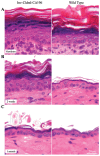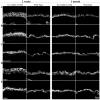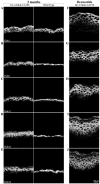Dermatitis and aging-related barrier dysfunction in transgenic mice overexpressing an epidermal-targeted claudin 6 tail deletion mutant
- PMID: 19915705
- PMCID: PMC2773045
- DOI: 10.1371/journal.pone.0007814
Dermatitis and aging-related barrier dysfunction in transgenic mice overexpressing an epidermal-targeted claudin 6 tail deletion mutant
Abstract
The barrier function of the skin protects the mammalian body against infection, dehydration, UV irradiation and temperature fluctuation. Barrier function is reduced with the skin's intrinsic aging process, however the molecular mechanisms involved are unknown. We previously demonstrated that Claudin (Cldn)-containing tight junctions (TJs) are essential in the development of the epidermis and that transgenic mice overexpressing Cldn6 in the suprabasal layers of the epidermis undergo a perturbed terminal differentiation program characterized in part by reduced barrier function. To dissect further the mechanisms by which Cldn6 acts during epithelial differentiation, we overexpressed a Cldn6 cytoplasmic tail deletion mutant in the suprabasal compartment of the transgenic mouse epidermis. Although there were no gross phenotypic abnormalities at birth, subtle epidermal anomalies were present that disappeared by one month of age, indicative of a robust injury response. However, with aging, epidermal changes with eventual chronic dermatitis appeared with a concomitant barrier dysfunction manifested in increased trans-epidermal water loss. Immunohistochemical analysis revealed aberrant suprabasal Cldn localization with marked down-regulation of Cldn1. Both the proliferative and terminal differentiation compartments were perturbed as evidenced by mislocalization of multiple epidermal markers. These results suggest that the normally robust injury response mechanism of the epidermis is lost in the aging Involucrin-Cldn6-CDelta196 transgenic epidermis, and provide a model for evaluation of aging-related skin changes.
Conflict of interest statement
Figures







Similar articles
-
Involucrin-claudin-6 tail deletion mutant (CDelta206) transgenic mice: a model of delayed epidermal permeability barrier formation and repair.Dis Model Mech. 2010 Mar-Apr;3(3-4):167-80. doi: 10.1242/dmm.002634. Epub 2010 Jan 27. Dis Model Mech. 2010. PMID: 20106878
-
The targeted overexpression of a Claudin mutant in the epidermis of transgenic mice elicits striking epidermal and hair follicle abnormalities.Mol Biotechnol. 2007 Jun;36(2):166-74. doi: 10.1007/s12033-007-0027-z. Mol Biotechnol. 2007. PMID: 17914196
-
Role of the Cldn6 cytoplasmic tail domain in membrane targeting and epidermal differentiation in vivo.Mol Cell Biol. 2006 Aug;26(15):5876-87. doi: 10.1128/MCB.02342-05. Mol Cell Biol. 2006. PMID: 16847338 Free PMC article.
-
Tight junctions in epidermis: from barrier to keratinization.Eur J Dermatol. 2011 Jan-Feb;21(1):12-7. doi: 10.1684/ejd.2010.1192. Eur J Dermatol. 2011. PMID: 21300606 Review.
-
Could tight junctions regulate the barrier function of the aged skin?J Dermatol Sci. 2016 Mar;81(3):147-52. doi: 10.1016/j.jdermsci.2015.11.009. Epub 2015 Nov 28. J Dermatol Sci. 2016. PMID: 26639794 Review.
Cited by
-
Deconstructing the skin: cytoarchitectural determinants of epidermal morphogenesis.Nat Rev Mol Cell Biol. 2011 Aug 23;12(9):565-80. doi: 10.1038/nrm3175. Nat Rev Mol Cell Biol. 2011. PMID: 21860392 Free PMC article. Review.
-
Tight junction defects in patients with atopic dermatitis.J Allergy Clin Immunol. 2011 Mar;127(3):773-86.e1-7. doi: 10.1016/j.jaci.2010.10.018. Epub 2010 Dec 15. J Allergy Clin Immunol. 2011. PMID: 21163515 Free PMC article.
-
A Retrospective Review of Chronic Non-Communicable Dermatoses Among Older Adults at a Tertiary Healthcare Facility in Southwestern Nigeria.Dermatol Pract Concept. 2023 Oct 1;13(4):e2023262. doi: 10.5826/dpc.1304a262. Dermatol Pract Concept. 2023. PMID: 37992368 Free PMC article.
-
Time- and dose-dependent claudin contribution to biological functions: Lessons from claudin-1 in skin.Tissue Barriers. 2017 Jul 3;5(3):e1336194. doi: 10.1080/21688370.2017.1336194. Epub 2017 Jun 19. Tissue Barriers. 2017. PMID: 28650689 Free PMC article.
-
Pathological molecular mechanism of symptomatic late-onset Fuchs endothelial corneal dystrophy by bioinformatic analysis.PLoS One. 2018 May 22;13(5):e0197750. doi: 10.1371/journal.pone.0197750. eCollection 2018. PLoS One. 2018. PMID: 29787599 Free PMC article.
References
-
- Fuchs E, Raghavan S. Getting under the skin of epidermal morphogenesis. Nat Rev Genet. 2002;3:199–209. - PubMed
-
- Turksen K, Troy TC. Epidermal cell lineage. Biochem Cell Biol. 1998;76:889–898. - PubMed
-
- Pouillot A, Dayan N, Polla AS, Polla LL, Polla BS. The stratum corneum: a double paradox. J Cosmet Dermatol. 2008;7:143–148. - PubMed
Publication types
MeSH terms
Substances
Grants and funding
LinkOut - more resources
Full Text Sources
Medical
Molecular Biology Databases

